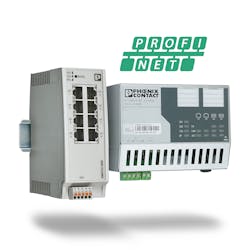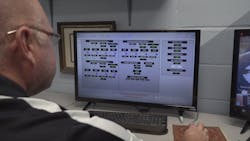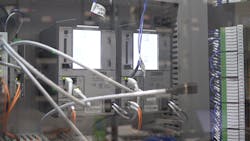Profinet: Designed for Openness and Determinism
When your factory runs only three months a year, you’re always investing in ways to increase the yield from your equipment. That’s why Joey Scarborough, general manager of the cotton gin facility owned by the Mildstead Farm Group in Shorter, Ala., chose Profinet for its industrial Ethernet communications to pass data between controllers and automation devices.
Part of Milstead Farm’s operating strategy is to be proactive at continuously maintaining and improving the gin’s equipment and process controls. A combination of proper maintenance and new equipment has been largely responsible for a gradual, but steady increase in the gin’s productivity over the years. Production topped 50 bales per hour in 2018, double the initial 25 bales an hour that the gin could process when operations began in 1998.
Scarborough believes Milstead Farm’s program of continuous improvement will be easier to perpetuate with Profinet as the backbone protocol of its control network. This open protocol defines both cyclic and acyclic communications among the Profinet components connected to standard Ethernet cables. With the protocol, the network can accommodate any Profinet product developed by hundreds of automation vendors. This includes programmable logic controllers (PLCs), programmable automation controllers (PACs), drives, robots, input-output devices (I/Os), and diagnostic tools.
Profinet also prepares Milstead Farm’s gin for the future. Although the existing Profibus network was still performing quite well, it was approaching its design limits in terms of node counts and cable distance, according to David Adams, the systems integrator at Design Automated Controls who performed the upgrade.
Besides extending these limits, Profinet also increased data transfer rates and integrated easily with the company’s existing Profibus network. The new central processing unit (CPU) has Profibus and Profinet onboard, so it permits the machinery still using the Profibus protocol to communicate seamlessly with the control system.
Perhaps just as important is the path that Profinet opens for future upgrades. Among the first upgrades Milstead Farms has planned are the new Ethernet-based human-machine interfaces (HMIs) to replace the five aging HMIs on the Profibus network. The new HMIs will provide Milstead Farms with more—and better— troubleshooting tools.
His reasoning is that a fully functional fieldbus does more than simply transfer bits and bytes among devices on the factory floor. It also facilitates such things as diagnostics, configuration, redundancy, vertical integration, functional safety, and energy management. “Many of these capabilities in Profibus are baked into Profinet,” says Bowne.
The big difference between the two, of course, lies in the physical layer. Whereas Profibus relies on RS-485, Profinet uses Ethernet. “This opens a world of possibilities,” observes Bowne. “Ethernet speeds are orders of magnitude greater.” Profinet’s telegram size is also larger, and Ethernet’s full-duplex nature allows Profinet to send and receive data simultaneously.
Besides handling larger amounts of bi-directional data, the Ethernet-based backbone also permits open communications. “Other protocols— such as OPC UA or HTTP—can coexist on a Profinet network,” says Bowne, indicating that “the network is now an infrastructure.”
These attributes have enabled Profinet to grow beyond its historic uses in industrial automation networking.
“The very first iteration of Profinet was developed for machine-to-machine integration,” notes Bowne. At the time, it was believed that “serial-based fieldbuses like Profibus would be used at the field level and that horizontal integration at the controller level would be achieved via Ethernet-based Profinet.”
Almost immediately, however, the automation industry found that Profinet would also work at the field level. Consequently, Profinet has progressed over the two decades since to include features for motion control, process automation, functional safety, and energy management.
Another benefit of Profinet is its determinism, which is not a native characteristic of Ethernet. Profinet can bring determinism to the factory floor by skipping the TCP/UDP and IP layers of the ISO/OSI Model and going directly from the data link layer (Layer 2) to the application layer (Layer 7) of the OSI model. This means that applications requiring synchronized, high-speed motion can use Profinet IRT (isochronous real-time) to provide sub-millisecond cycle times.
Bowne points out that many of the mechanisms in Profinet IRT are also found in the Time-Sensitive Networking (TSN) standard being developed by the Institute of Electrical and Electronics Engineers (IEEE). “From this perspective, Profinet is ready for TSN,” he says. “It’s already written into our spec.” He expects the first Profinet over TSN devices to be released in a year or two.
Further Ethernet developments promise to extend the reach of Profinet. One of these is Ethernet-APL (advanced physical layer), a technology that brings Ethernet to field devices in hazardous areas.
“It is an intrinsically safe version of IEEE 2-wire Ethernet (10BASE-T1L) that brings both power and communication to instruments at 10 Mbit/s over cables as long as 1 km,” explains Bowne. “The richness and transparency of Ethernet can now be utilized down to the field level in process automation.”
“Building a factory today requires a diverse mix of devices,” explains Bowne. “With Profinet, users are free to select best-of-breed solutions from their vendors of choice and can rest assured that these products will communicate properly.”
Vendor agnosticism was part of the plan from the beginning, even though Profinet was originally conceived as the industrial communications protocol for Siemens products.
“Siemens understands that users don’t want to be tied to one specific vendor or a proprietary technology,” says Torsten Paulsen, general manager of the Profi Interface Center, Siemens Industry Inc.
For this reason, the company chose not to pursue what Paulsen describes as the easy route when industrial Ethernet emerged in the early 2000s. Rather than mapping its well-established Profibus protocol into existing Ethernet protocols like TCP/IP and UDP/IP, Siemens instead decided to develop the protocol as an open and vendor-independent technology.
It did so by founding Profibus and Profinet International, a consortium that manages the technology and its evolution. “After the original patents were written and finalized, the intellectual property rights were handed over to PI,” reports Bowne. “Any company that joins PI as a member, anywhere in the world, is granted rights to these patents.” PI is now governed by a board of directors composed of representatives of the member companies.
These member companies joined and supported this and similar consortia for the same reasons that Siemens organized PI. Phoenix Contact, for example, joined PI in 2004 to develop a migration path to an Ethernet platform for its own InterBus fieldbus. “The choice of going it alone with our own Ethernet-based platform made no sense,” says Arnold Offner, strategic marketing manager, automation infrastructure at Phoenix Contact.
Like other member companies, Phoenix Contact allocates resources to support PI. This includes selecting employees to sit on the governing board of directors and participating on various technical committees and working groups. “Our employees are still working at the Phoenix Contact offices,” explains Offner. “They do in-house testing to verify what other members are uncovering, build up designs, and verify that these designs will work with our own products.”
As a member, Siemens also has employees performing many similar functions as Phoenic Contact. Siemens also “supports and staffs several PI testing labs, training centers, and competence centers around the globe,” says Paulsen. An example is the Profi Interface Center he manages. This combined competence center, training center, and testing lab has been certified and accredited by PI to support the PI community in North America.




